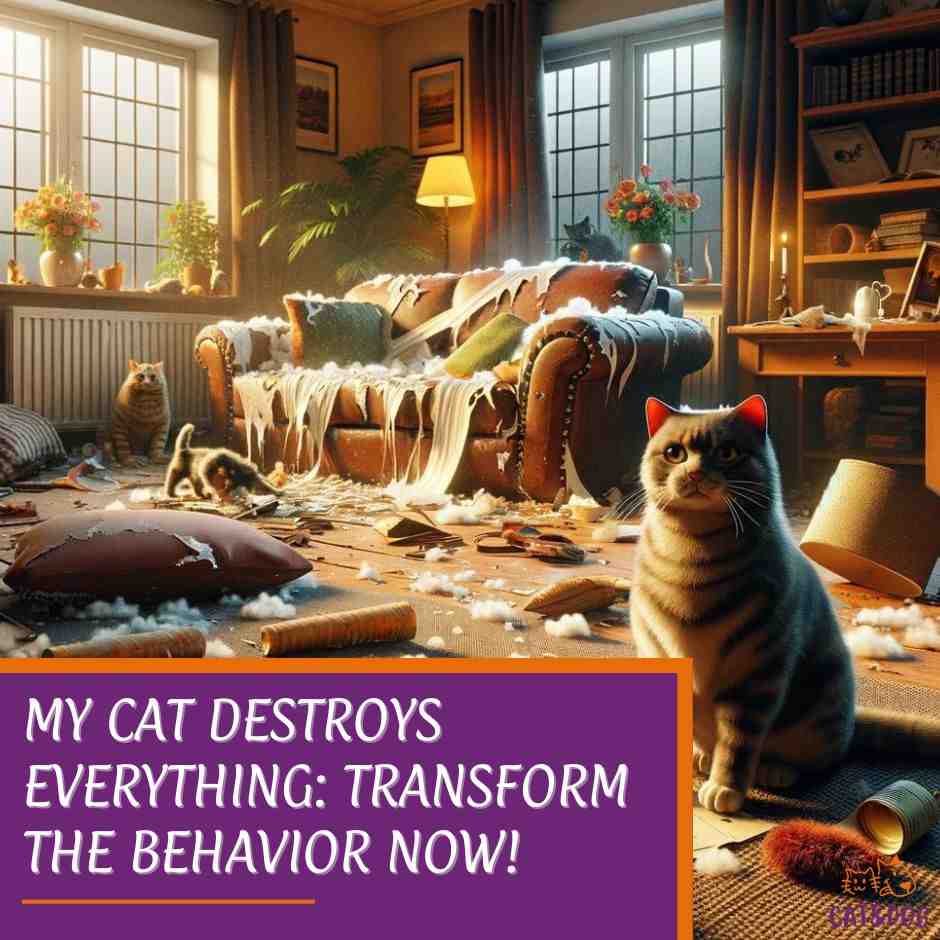Are you tired of coming home to a living room that looks like the aftermath of a feline tornado?
It can be exasperating to find your treasured possessions turned into chew toys or your furniture clawed to threads.
So, “why my cat destroys everything?” If your cat is wreaking havoc on your home, you’re likely looking for answers and solutions.
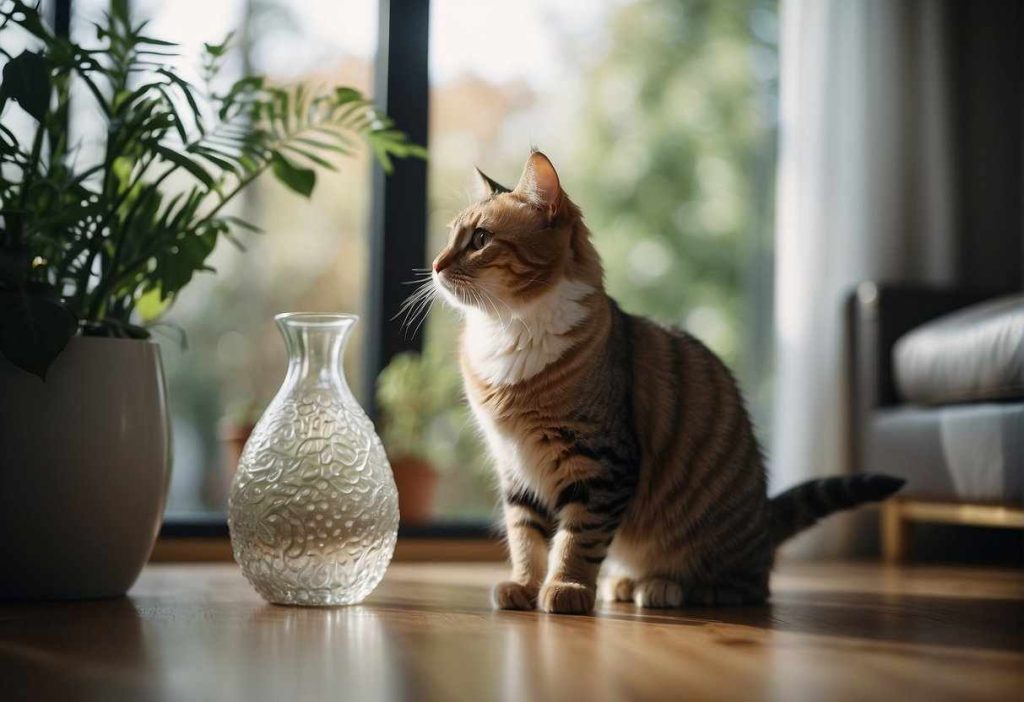
Understanding your cat’s destructive behavior is crucial in finding a way to coexist peacefully. (1)
Rest assured, some strategies can help.
The reasons behind your cat’s urge to destroy are not just whims; they’re often rooted in instincts or unmet needs. (2)
We’ll explore the ways you can redirect these behaviors and create a happier environment for you both.
Creating an enriching space and routine for your cat is vital. (3)
This isn’t just about saving your stuff—it’s about strengthening the bond between you and your whiskered companion.
A happy cat is more likely to be a well-behaved cat.
So, if you’ve been despairing over your demolished belongings, there’s light at the end of the tunnel.
Key Takeaways
- Destructive behavior in cats can be managed with proper understanding and techniques.
- Immediate solutions and comprehensive training can drastically reduce unwanted behavior.
- Long-term behavioral change involves creating an enriching environment and addressing health issues.
My Cat Destroys Everything: Immediate Solutions
Providing Appropriate Scratching Posts
- Types: Offer a variety of scratching posts.
- Cats love diversity—tall ones, short ones, horizontal, and vertical.
- Positioning: Place them near your cat’s favorite hangout spots. Accessibility is key!
Visual guide:
| Type | Location Suggestion |
|---|---|
| Tall scratching post | Next to the couch |
| Horizontal scratcher | Under the window sill |
| Cardboard scratch pad | Near their sleeping area |
Interactive Toys and Playtime
You know what they say: ‘A playful cat is a happy cat.’ It’s essential to keep those paws busy.
Without further ado, here are some objectively awesome toys:
- Laser pointer: A little light can lead to a lot of fun.
- Feather wands: Are you a bird? No, but waving a feather wand might make you feel like one!
- Puzzle feeders: Who says you can’t teach an old cat new tricks? These feeders do!
Remember, playtime isn’t just fun and games—it’s a furry-fect way to bond with your kitty.
So, grab that toy, schedule some daily play, and watch the unwanted behavior fade away.
Keep those conversations going, “Who’s the best hunter? Yes, you are!” and watch your sofa and sanity remain intact!
Understanding the Root Causes of Destructive Behavior

Identifying Behavioral vs. Medical Causes
- There’s a fine line between a bored cat and one that’s acting out due to discomfort.
- Does your cat have enough toys and attention, or could there be an underlying dental issue causing them discomfort?
- It’s like detective work: observe and investigate!
- Boredom: It’s crucial to differentiate between a cat’s need for stimulation and possible health issues.
- Keep an eye out for these signs:
- Excessive scratching (4)
- Random sprinting
- Knocking things over
- Medical Issues: Sometimes, it’s not mischief but a cry for help.
- Be on the lookout for:
- Reduced appetite
- Changes in litter habits (5)
- Unusual chewing (possibly indicating dental pain or pica)
The Impact of Environment on Cat Behavior
- Make sure your living space is set up for your cat to thrive.
- Cats are climbers and explorers by nature, and they require an environment that stimulates their instincts.
- Ensure there are ample vertical spaces and scratching posts.
- Consider cat trees or shelves—they could be the ‘height’ of fun for your kitty.
Remember, understanding is the first step to harmony in your home.
Keep these factors in mind, and you’ll be on your way to solving the mystery of your cat’s destructive antics!
Comprehensive Behavioral Training Techniques

Let’s tackle that with some Positive Reinforcement and Clicker Training. (6)
Picture this: your cat does something good; immediately, a click sound followed by a tasty treat.
That click tells your furry friend, “A+ for effort!” and the treat is their gold star. Try this:
- Get a clicker and some treats your cat can’t resist.
- When your cat behaves, click and treat.
- Repeat! Consistency is key.
Felines are unique, and as such, Customizable Solutions for Unique Behaviors are a must.
You know your cat better than anyone else.
Does she go bananas for a feather wand? Or maybe a belly rub is her slice of heaven?
Use these preferences to your advantage in training. For example:
- If she scratches the couch, provide a scratching post rubbed with catnip.
- Enjoying a peaceful moment without chaos? Give a cuddle or playtime as a reward.
Step-by-step guide on implementing training techniques: Let’s break it down into bite-sized pieces.
- Identify the behavior you want to encourage or discourage.
- Choose a reward that will motivate your cat.
- Select a quiet time for training sessions to avoid distractions.
It’s all about making the experience enjoyable for both of you.
Your patience will pay off with a happier, less destructive kitty.
Remember, cats have personalities too, so some trial and error is normal. Keep at it and watch the transformation unfold!
Creating a Stimulating and Enriching Environment

Sensory Richness: Tailored to Their Whiskers
- Sounds: Consider toys that chirp or rattle to mimic prey.
- Sights: Window perches offer a great view of the outdoors.
- Smells: Catnip and silver vine can provide a delightful sensory experience.
Instinct Fulfillment: Scratch the Itch (And Not Your Furniture!)
- Specifically designed scratching posts or pads protect your belongings and keep your cat’s claws healthy.
- Engaging toys, like laser pointers or feather wands, allow for safe and fun predatory play.
Safe Havens: Your Cat’s Personal Fortress of Solitude
- Cat trees with multiple levels provide vantage points and serve as safe retreats.
- Hidden nooks, such as a box or a shelf, satisfy their need for concealment.
Escape Routes: Highways in the Sky
- Shelves or furniture arranged to create a path allow for vertical exploration and exercise.
Don’t forget about engagement!
Spend time each day playing with your cat to strengthen your bond and burn off additional energy.
Remember, a bored cat can be a destructive cat, but with these tips, your whiskered companion can become more content and less likely to redecorate your home in, let’s say, ‘unique’ ways.
Health Checks: Preventing and Recognizing Medical Issues
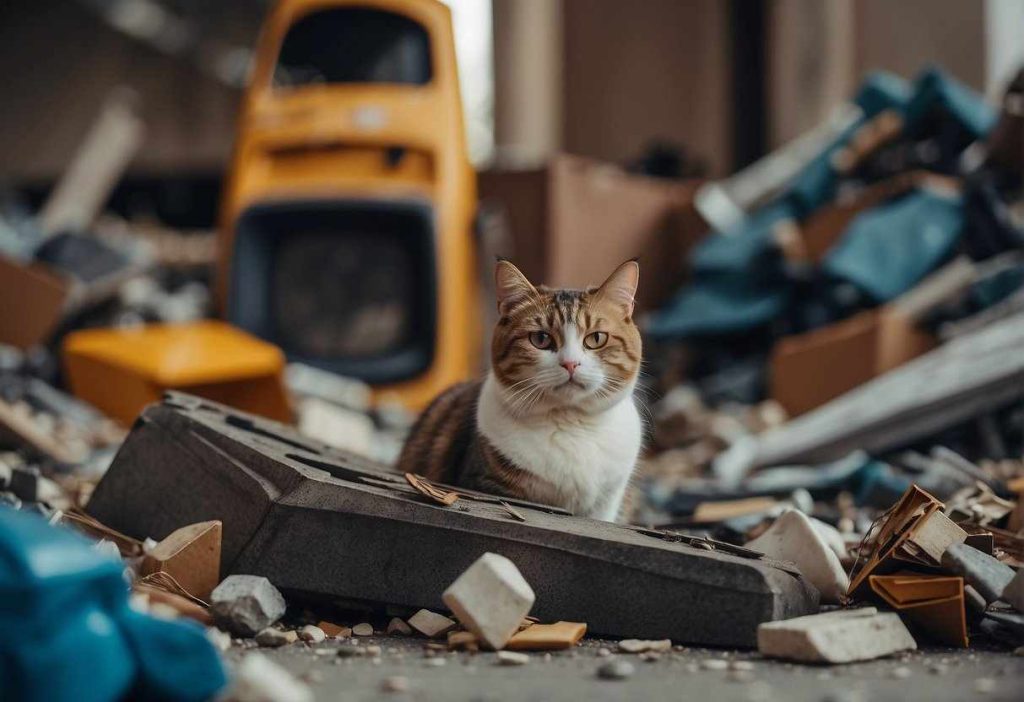
Common Health Issues Leading to Destructiveness:
- Dental Issues: Cats with tooth pain may try to relieve discomfort by biting or chewing objects.
- Pica: An urge to eat non-food items, can lead to destructive behavior.
- Anxiety: Just like us, cats can feel anxious, which may result in them lashing out at your belongings. (7)
To stay ahead of these issues, you’ve got to be a pet detective of sorts. Pay attention to odd behaviors and seek professional advice.
The Role of Regular Veterinary Check-ups:
- Preventive Care: Like maintaining your car, regular check-ups can prevent bigger issues down the road.
- Cats are masters at hiding pain, so it’s crucial to identify problems early.
- Early Detection: Catching issues before they escalate can save your cat from discomfort and your home from disaster!
Here’s what you can do:
- Annual Vet Visits: Ensure your furry friend has annual check-ups to catch any signs of trouble early.
- Watch for Behavioral Changes: Changes in eating, bathroom habits, or activity levels can be a red flag.
- Mental Stimulation: Keep your cat’s mind engaged with new toys and games – a busy cat is a less destructive cat.
- Dental Care: Brush those feline teeth or use dental treats to combat dental diseases.
Long-term Behavioral Change and Understanding

Building a Routine and Structure
Why is your cat doing this?
Often, it’s out of boredom or excess energy.
Creating a consistent routine is like giving your feline friend a blueprint for their day:
- Scheduled playtimes.
- Fixed feeding hours.
- Regular grooming sessions.
Think of it as setting up a ‘cat agenda’—they’ll know what’s happening when providing a sense of security and order.
Advanced Behavioral Issues and Interventions
Now, if the destruction derby continues, you might be dealing with more deep-seated behavior issues.
It’s like being a detective—some clues lead to the need for expert advice. Here’s when you may need to tag in a professional:
- Unchangeable destructive habits.
- Aggression or significant changes in behavior.
- Signs of anxiety or stress that don’t ease up.
These are the moments to chat with a vet or a cat behaviorist who can offer tailored strategies for behavioral modification.
They’re the feline version of personal coaches and can help turn chaos into calm. Remember, there’s no shame in asking for help!
So, whether it’s enhancing their daily routine or seeking extra guidance, understanding your cat’s needs and steering their behavior for the better can make a huge difference.
Ready to team up with your kitty and create a harmonious living space? You’ve got this!
Sustainable and Eco-Friendly Solutions
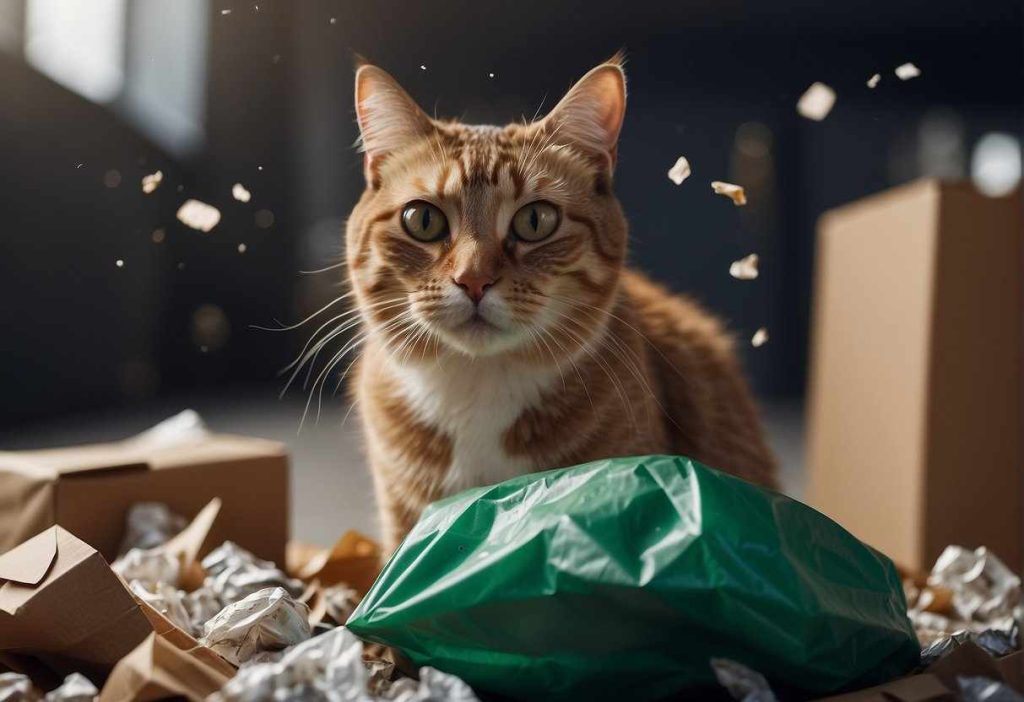
How about sustainable pet products that save your stuff and the planet? Here’s the scoop:
- Bamboo and Sisal: Replace those plastic toys with bamboo bases and sisal ropes. They’re tough, renewable, and biodegradable.
- Natural Scratch Pads: Get your hands on a scratch pad made from recycled cardboard. Your cat gets to scratch away, and you get peace of mind.
| Material | Benefits | Lifespan |
|---|---|---|
| Bamboo | Renewable, eco-friendly | Long-lasting |
| Sisal | Biodegradable, strong | Long-lasting |
| Recycled Paper | Non-toxic, compostable | Varies |
Ever heard of pheromone diffusers or sprays?
They release a scent that calms your kitty, cutting down on the chaos. And guess what? They’re environmentally safe.
Here’s a quick list of behavior management tips:
- Use natural calming sprays that are pet-safe and eco-friendly.
- Try organic catnip; it’s like a spa day for your cat.
- Invest in feline pheromone products for peace and quiet.
Remember, you’re not just saving your sofa; you’re setting an example.
Your cat doesn’t have to know you’re being a green hero, but every little bit helps. Time to let your cat have their fun – sustainably!
Enhancing Trust and Communication

Recognizing Signs of Stress and Anxiety
Ever noticed your cat hiding more often, or maybe they’re over-grooming? These could be signs your furry friend is stressed.
It’s crucial to understand when they’re feeling anxious to address their emotional needs properly.
- Symptoms of Stress:
- Excessive grooming
- Avoidance behaviors
- Changes in eating habits
Addressing their emotional needs is a step toward a calmer, less destructive kitty.
Have you tried puzzle feeders or new toys? These can engage your cat’s mind and reduce stress.
The Importance of Cuddle Time and Attention
Cats are just like us sometimes; they need a good hug!
Dedicating time for affection strengthens your bond and can prevent those pesky attention-seeking behaviors. Here’s how you can integrate quality time into your daily routine:
| Day | Cuddle Time |
|---|---|
| Mon | 10 mins AM |
| Tue | 15 mins PM |
| Wed | 10 mins AM |
| … | … |
Mix up your interactions with play sessions too! Try a feather wand or a laser pointer.
Studies show that interactive play can reduce behavioral issues in cats.
Remember, a tired cat is a happy cat.
When you communicate effectively with your cat through understanding and responding to their needs, you build a foundation of trust.
This can lead to a reduction in their destructive tendencies as they feel more secure and less inclined to express anxiety through negative behavior.
Keep up the cuddles, and playtime, and stay observant. Your cat will thank you for it – probably not with words, but certainly with purrs and affection.
Leveraging Expertise and Authority
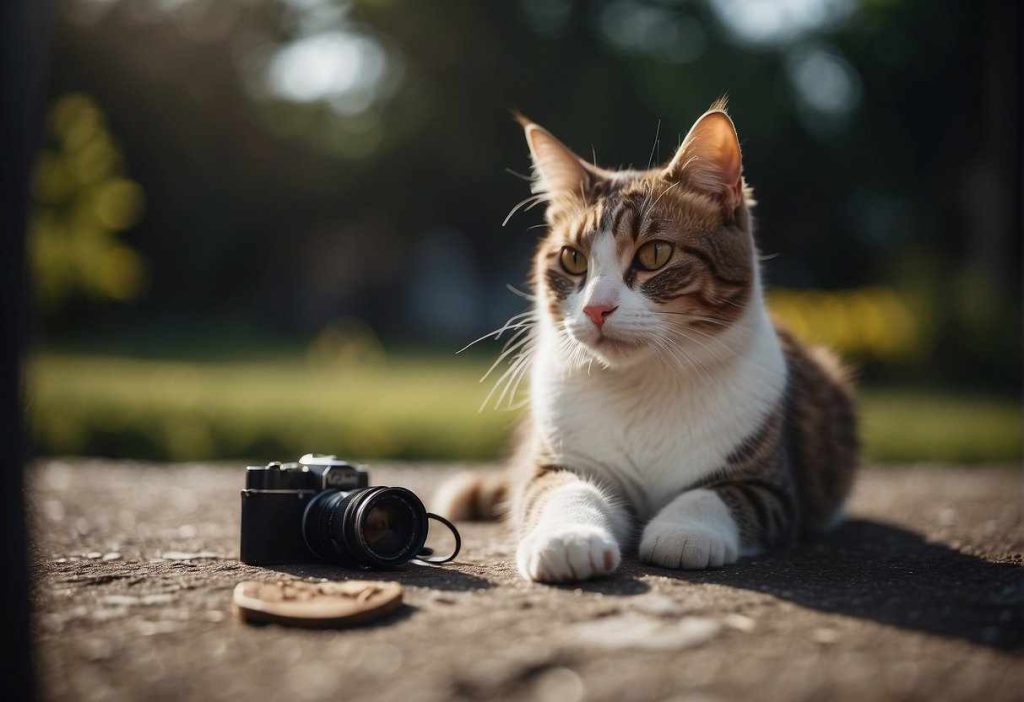
Meet Dr. Whiskerpaws, a feline behavioral specialist.
With over 20 years of experience, she believes understanding your cat is key:
- Daily playtime reduces pent-up energy.
- Scratching posts provide a healthy outlet.
- Consistent routines reduce anxiety.
Curious about others like you? Take Michael, who followed Dr. Whiskerpaws’ advice and saw a 50% drop in cat-related chaos. Or Emily, who swears by pheromone diffusers to calm her kitty.
Table: Pro Tips to Deter Destruction
| Strategy | Success Rate | Author |
|---|---|---|
| Scheduled Play | 80% | Dr. Purr |
| Scratching Post | 75% | Cat Care Ltd |
| Routine | 70% | Dr. Whiskerpaws |
Community insights play a huge role! Join forums and share your stories; it’s all about learning from each other.
Ever tried placing double-sided tape where your cat scratches? It’s a non-toxic deterrent and a tip passed around in savvy cat circles.
- List of DIY Tips:
- Double-sided tape
- Citrus peel (cats dislike the smell)
- Vertical space (shelves for climbing)
Remember, patience is key.
Cats are creatures of habit, and change takes time. Addressing undesirable behavior with smart, expert-backed tactics could be your ticket to a peaceful home.
So, ready to team up with your feline friend instead of facing off? Embrace these insights, and your cat might just become the purr-fect roommate!
Quick Recap
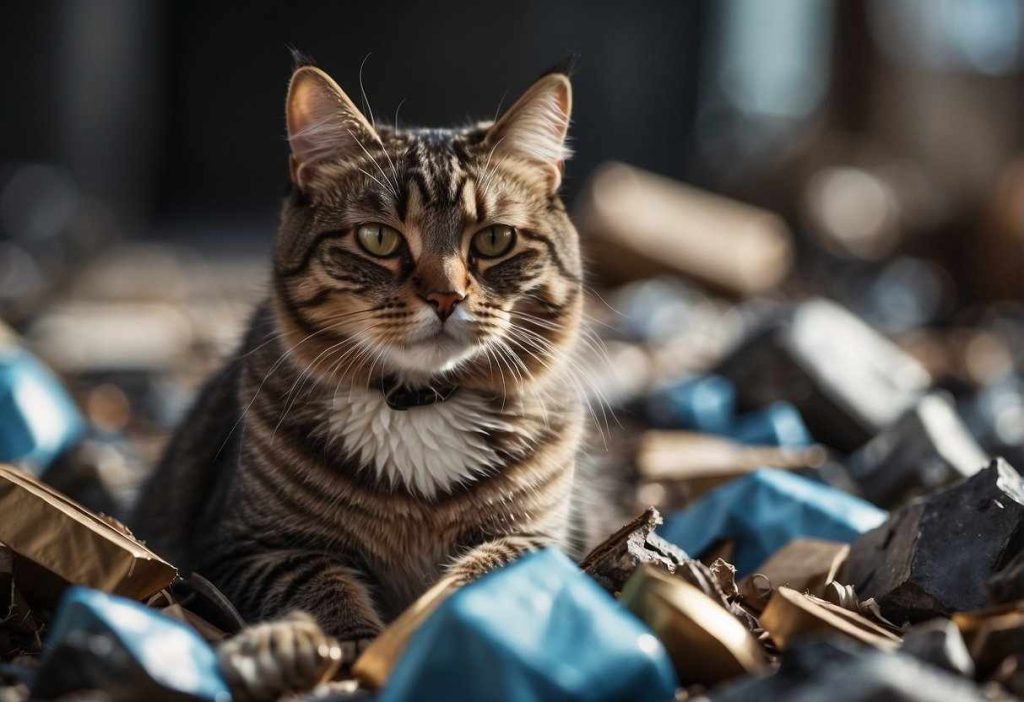
Understanding the Whys:
- Cats have natural hunting instincts; they’re not being spiteful!
- The destruction is a way to release energy and fulfill innate needs.
Empathy is Key:
It’s vital to approach the situation with empathy. Try to put yourself in their paws and imagine the world from their perspective.
Simple Strategies:
- Interactive Toys: Redirect their energy toward suitable outlets.
- Scratching Posts: Offer alternative options to your furniture.
- Routine Playtime: Schedule regular sessions to satisfy their prey drive.
Building a stronger bond comes through understanding and supporting their instincts. You’ll be less of a referee and more of an ally in their day-to-day adventures.
It’s about finding a balance that leaves both you and your cat purring with contentment.
Frequently Asked Questions
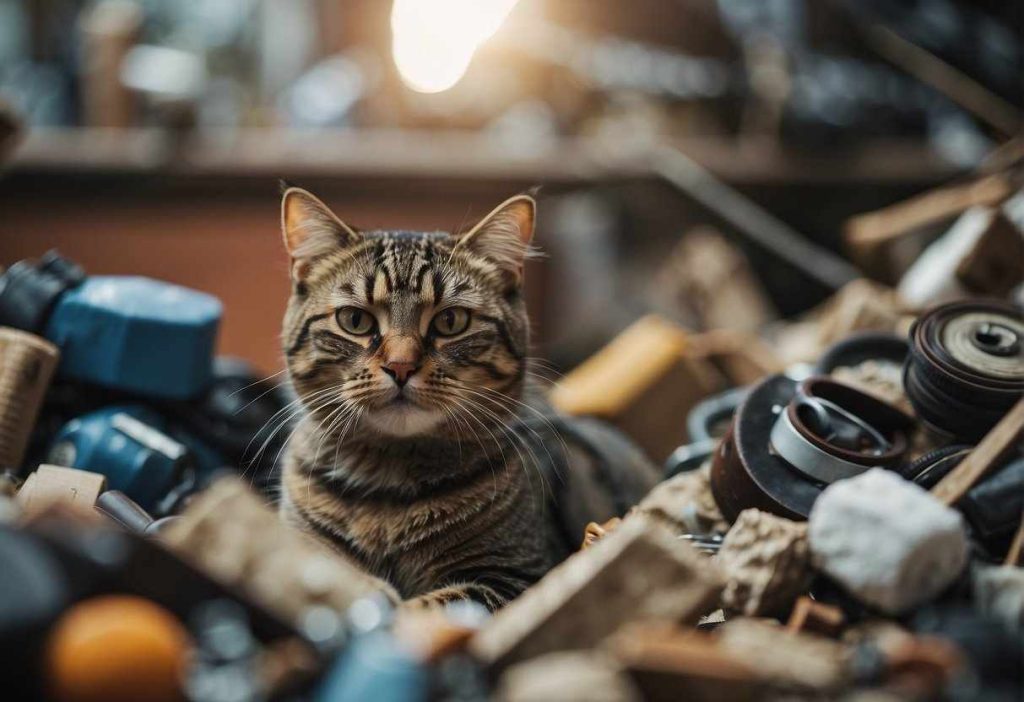
Having a feline companion can be a delightful experience, but when your cat starts treating your home like a personal jungle gym, it’s time for some quick and effective solutions.
Why does my cat scratch furniture and how can I stop it?
Your cat is not scratching your favorite chair out of spite; it’s their natural way to keep claws sharp and to leave visual and scent markers.
To deter them, provide scratching posts and pads, and employ deterrents such as sticky tape on furniture.
Positive reinforcement when they use appropriate scratching surfaces can work wonders, too.
Can medical issues cause destructive behavior in cats?
Absolutely; if your normally well-behaved cat suddenly goes on a rampage, it might be worth a trip to the vet.
Pain or discomfort from conditions like arthritis or dental disease could be causing them to lash out on your belongings.
How can I keep my cat entertained while I’m not home?
Boredom is the root of many destructive behaviors.
Keep your cat entertained with puzzle feeders, perch with a view, or a bird feeder outside the window. Make sure they have a variety of toys and rotate them to maintain interest.
What are the best toys to prevent my cat from destroying household items?
Toys that mimic the prey, like feather wands and mouse toys, can be irresistible.
Interactive toys that require your cat to work for treats can also keep them busy.
Heavy-duty toys designed for aggressive play will withstand vigorous use.
How can I train my cat to stop unwanted behavior?
Cats respond well to positive reinforcement.
Reward your cat with treats, affection, or playtime when they engage in good behavior. Consistency is key, and be patient; training takes time.
Is it okay to punish my cat for destructive behavior?
Punishing your cat can lead to fear and anxiety, which could exacerbate the destructive behavior.
Instead, try redirecting their attention to acceptable activities and reward them for good behavior.
How do I protect my furniture from my cat’s claws?
Use furniture protectors like plastic covers, or apply double-sided tape to deter your cat.
Trimming their claws regularly will also minimize damage, and don’t forget the power of distraction—give them their fun and appealing objects to scratch.

